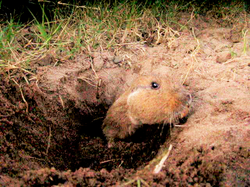| Collared tuco-tuco | |
|---|---|
 | |
| Scientific classification | |
| Kingdom: | Animalia |
| Phylum: | Chordata |
| Class: | Mammalia |
| Order: | Rodentia |
| Family: | Ctenomyidae |
| Genus: | Ctenomys |
| Species: | C. torquatus |
| Binomial name | |
| Ctenomys torquatus Lichtenstein, 1830 | |
The collared tuco-tuco (Ctenomys torquatus) is a tuco-tuco species from South America. It is found in southern Brazil, Uruguay and northern Argentina, where it lives underground in a burrow it digs in savannah habitats. It is a relatively common species and the IUCN has assessed its conservation status as being of "least concern".
